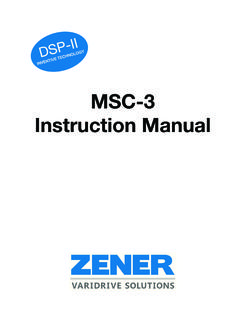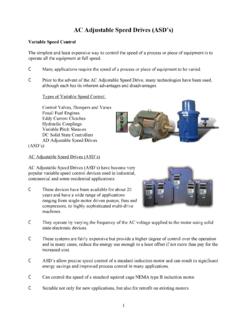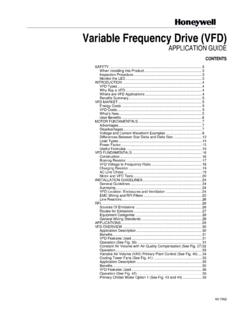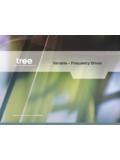Transcription of Specifying a Variable Frequency Drive - WMEA
1 Specifying a Variable Frequency Drive 's Put on by Bruce Reeves and Jeremy Gonzales Dykman Electrical Covering the Western US. For all of your VFD and Soft Start and Motor Needs How To Specify a Variable Frequency Drive What is the application? Is it a Variable torque or Constant Torque? Is it heavy duty or light duty light Variable Torque VS Constant Torque First let's define these two terms above. Variable torque applications: These AC motors have a speed torque characteristic that varies as the square of the speed . For example, a 1,800/900-rpm electrical motor that develops 10. hp at 1,800 rpm produces hp at 900 rpm. Typical examples of some common Variable torque applications are centrifugal pumps, fans, and blowers, (Positive displacement pumps not included.). Variable Torque VS Constant Torque Constant Torque applications: These AC. motors can develop the same torque at each speed , thus power output varies directly with speed .
2 For example, an AC motor rated at 10. hp at 1,800 rpm produces 5 hp at 900 rpm. Typical examples of some common constant torque applications are mixers, conveyors, and compressors. Variable Torque VS Constant Torque Light duty is typically reserved for Variable torque applications and with some manufacturers the terms used are light or normal duty instead of Variable torque. It is directly related to the overload capacity of the VFD, In Light or normal duty applications the overload is defined as being able to produce an overload of 120% for one minute. Variable Torque VS Constant Torque Heavy duty is typically reserved for constant torque applications and with some manufacturers the term heavy duty is used instead of constant torque. Again it is directly related to the overload capacity of the VFD, In heavy duty applications the overload is defined as being able to produce an overload of 150% for one minute.
3 Variable Torque VS Constant Torque So these first two terms can and are used to describe the application and are critical in Specifying a VFD. Motor Name Plate And What To Look For Full Load Amps Full load amps should be used with HP in sizing a Drive Horsepower Even though Current is the big factor we a still need to size the VFD for at minimum for the HP rating of the motor. We use the HP and current to properly size the VFD. RPM. VFD's are typically built on the standards of a 4 pole 1800 RPM motor. The big key again is looking at HP and FLA to determine the proper size of the Drive Lower RPM motors will typically have a higher FLA which should be reflected on the nameplate Motor Cooling Method Important for setting the motor thermal overload protection. Is the motor a TEFC, Fan Cooled or other type of motor, these are settings we need to know in programming the Drive Improper settings can cause alarms in the VFD.
4 Generator Operation Be sure to properly size a generator to be sure the voltage and Frequency considerations are properly met Marginal sized generators will cause problems with VFD operations Drives are typically rated for the below specs +/- 10% voltage fluctuation Supply Voltage +/- 3% Frequency variation Voltage sag ride-through for the following: 0% voltage for 1 cycle 60% voltage for 10 cycles 87% voltage continuous Single Phase input to a 3 Phase Motor VFD's can be used to supply a 3-phase Drive with single-phase power, then the Drive must be derated by 25% to 50% of its current-handling ability, which will require you to specify a larger-sized Drive . Programming options might have to be disabled to allow this operation. Enclosure Type NEMA 1: Open style Drive only for mounting on a wall in or in an existing enclosure, If on a wall, end caps or gland plates might have to be ordered to accommodate conduit or connectors.
5 This Drive is open to the environment and unprotected from dust, water or other environmental hazards. Enclosure Type NEMA 12: Dust tight and will be mounted in an enclosure with fans and filters NEMA 3R: Rain tight enclosure with fans and filters NEMA 4X: Wash down enclosure with heat exchanger or air conditioner instead of fans and filters Some drives can be purchased in a 4X. configuration without an enclosure but typically have limited horse power ranges in this configuration Control Methods for Variable Frequency Drives 2-wire control, only one switch is used to run the Variable Frequency Drive . An open switch stops the Drive , and a closed switch starts the Drive . A second switch could reverse the motor with a run command. Control Methods for Variable Frequency Drives With 3-wire control, two switches are used to run the Drive . One switch is needed to stop, might be called Drive enable and another to start the Variable Frequency Drive .
6 This allows an auxiliary contact from the start to "seal in" the RUN command, just like your more conventional motor starters. Along with this you would have another switch if you needed to reverse the direction. speed Reference Sources Digital Operator on the VFD, typically up and down arrow keys speed Potentiometer. Allows the operator to set motor speed with pot. speed Reference Sources Analog Signal Follower. 4-20mA or 0-10 VDC; must provide Variable Frequency drives with an isolated input; must use a twisted/shielded pair and keep wire away from 3-phase AC. speed Reference Sources Selector switch speed selection. Allows operator to select from several preset speeds. Can also be used if the speed is being set via a PLC, and an analog output is not available. speed Reference Sources Communications. Allow Variable Frequency drives to communicate on a network, such as MODBUS, PROFIBUS, DEVICENET, or Ethernet/IP AB Ethernet, enabling Drive operation to be coordinated and monitored from a PC.
7 speed Reference Sources Switching the Digital Operator Panel to Local Control allows control of the VFD through the keypad for troubleshooting or operator preference Now Sounds Confusing, why do you want to use a Drive ? Energy savings are usually the primary motivation for installing Variable Frequency drives for centrifugal applications, and Variable torque drives offer the greatest energy savings. For example, a fan needs less torque when running at 50% speed than it does when running at full speed . Variable torque operation allows the motor to apply only the torque needed, which results in reduced energy consumption. Now Sounds Confusing, why do you want to use a Drive ? Conveyors, positive displacement pumps, punch presses, extruders, and other similar type applications require constant level of torque at all speeds. In which case, constant torque Variable Frequency drives would be more appropriate for the job.
8 Energy savings in these applications will not be the primary concern but there are other benefits to be gained Just as important as energy savings is the control of the process speed Flow Seasonal concerns Eliminating valves, dampers Added motor and other mechanical life by reducing inrush encountered in across the line starting De-Rate for Temperature De-Rate for Carrier Frequency De-Rate for Elevation Part Two: Addressing Potential Issues Harmonics Meeting IEEE-519. Common Mode Voltage (Bearing Fluting). Long Lead Lengths Harmonics Harmonics are caused by nonlinear loads. A nonlinear load is any electronic device using solid state power switching supplies to convert incoming AC to DC: Personal Computers Florescent Lighting Uninterruptable Power Supplies (UPS). Variable Frequency Drives Harmonics Current Distortion Voltage and Current Distortion Harmonics The distorted current reflected throughout the electrical system causes either a voltage drop or severe voltage distortion.
9 High Fault Current (Stiff System) System Impedance is Low Voltage distortion is low Harmonic current draw is high Low Fault Current (Soft System) System Impedance is High Harmonics High Fault Current (Stiff System) System Impedance is Low Voltage Distortion is Low Harmonic Current Draw is High Low Fault Current (Soft System) System Impedance is High Voltage Distortion is High Harmonic Current Draw is Low Harmonics Harmonics cause problems with the distribution system or equipment on the system. Conductor Heating Reduced Capacitor Life False Trips or Failures of Breakers and Fuses Transformer Overheating Utility Meter can record measurements wrong Affect the operation of other VFD's and Control Equipment Harmonics There are several ways to reduce system Line Reactors Adds system harmonics: Impedance to reduce System Design Limit Non- harmonics Linear Load Harmonic Filters Either Multi-Pulse Front Ends tuned or passive; to eliminate Minimizes the order and harmonics (5th, 7th, 11th etc.)
10 Magnitude by cancellation Active Front End Uses Isolation Transformers IGBT's on front end of VFD;. Provides a neutral ground uses a higher switching reference to reduce nuisance Frequency than the system to ground faults reduce harmonics Bearing Fluting Bearing Fluting Electrical fluting occurs when a current is passed through the motor bearing instead of a grounded source PWM (Pulse Width Modulated) Drive switching frequencies result in undesirable motor shaft currents Bearing Fluting When the motor shaft is turning, the bearing grease insulates the bearing balls and the bearing race. The motor bearings and the race act as two capacitors. The stator and the rotor generate charge accumulation through capacitive coupling that is electrostatically induced in to the motor shaft. This current then passes through the motor shaft to the bearings and discharges from the balls with enough energy to pit the bearing race Bearing Fluting There are several solutions to mitigating bearing fluting issues Shaft Grounding Brush Diverts shaft currents from bearings directly to ground Insulated Bearings Bearing ball.





